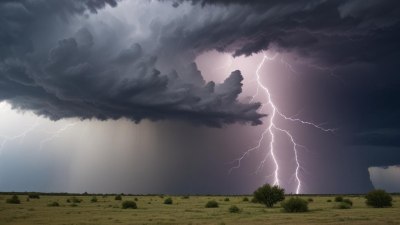How Hailstones Grow to the Size of Baseballs The Science of Giant Hail
Explore the fascinating science behind giant hailstones and how they grow to the size of baseballs.

This image was created with the assistance of Freepik
Hail is a destructive weather phenomenon that can cause significant damage to property and agriculture. While most people are familiar with small hailstones, few realize that under the right conditions, hailstones can grow to the size of baseballs. Understanding how these large hailstones form is crucial for predicting severe weather and mitigating its impacts.
What is Hail?
Hail is a type of precipitation that consists of balls or irregular lumps of ice. It forms in strong thunderstorms, particularly those with intense updrafts, where moisture-laden air is pushed upward into colder regions of the atmosphere. As this moisture freezes, ice pellets begin to form, and with the right conditions, they can grow to substantial sizes.
The Formation Process
The process of hail formation involves several key stages. Initially, raindrops are drawn into the storm's updraft. As they rise, they encounter temperatures below freezing, causing them to freeze into small ice nuclei. These tiny ice pellets are then carried upwards and downwards by turbulent winds within the thunderstorm.
Updrafts and Downdrafts
Strong updrafts are critical to hail growth. A powerful updraft can lift these ice pellets high into the colder regions of the storm, allowing them to accumulate layers of supercooled water. This water freezes upon contact with the cold ice nuclei, causing the hailstone to grow larger. Each time the hailstone is lifted and falls in a downdraft, it collects more supercooled water, gaining additional size and weight.
The Role of Supercooled Water
Supercooled water is essential for the growth of large hailstones. This phenomenon occurs when water remains liquid below its freezing point. In thunderstorms, supercooled droplets can exist within the updraft, and as hailstones collide with these droplets, they freeze instantly, adding layers to the hailstone.
Size Limits of Hailstones
While there is potential for hailstones to grow quite large, there are limitations. The strength of the storm's updraft is critical; it must be strong enough to support the weight of the hailstone as it continues to grow. Eventually, the hailstone will become too heavy for the updraft to sustain, and it will fall to the ground. The size of hailstones can vary widely, with some growing as large as 6 inches in diameter, resembling the size of a baseball.
Environmental Conditions
Specific environmental conditions are necessary for the formation of giant hailstones. These conditions include a warm, humid atmosphere at the surface combined with a cold atmosphere aloft. Such setups are commonly found in severe thunderstorms during the spring and summer months in certain regions, including the central United States, which is often referred to as “Hail Alley.”
Geographic Distribution
The geographic distribution of hail events is linked to the necessary atmospheric conditions for hailstone formation. Parts of the Great Plains, such as Colorado, Nebraska, and Texas, experience the highest frequency of large hail events. The flat terrain in these regions allows for the development of severe thunderstorms with robust updrafts.
Impacts of Large Hail
The impacts of large hailstones can be devastating. When these chunks of ice fall to the ground, they can cause significant damage to vehicles, rooftops, and crops. Farmers can suffer losses in their fields, with hail destroying crops in just minutes. Additionally, livestock can be injured, and injuries to people have been reported during severe hailstorms.
Historical Perspective
Throughout history, giant hailstones have been documented in various locations, with some notable events causing widespread damage. For instance, in 2010, a hailstorm in Colorado produced stones measuring nearly 8 inches in diameter, causing millions of dollars in damage. Such events emphasize the power of nature and the necessity of understanding hail formation and its potential consequences.
Preparation and Safety
Preparing for hailstorms is essential, especially in regions prone to severe weather. Residents should be informed about weather forecasts, seek shelter during storms, and protect their property by moving vehicles into garages or covered areas. Understanding the signs of severe thunderstorms can provide critical time to take safety precautions.
Climate Change Factors
Climate change may also influence the frequency and intensity of severe weather events, including hail. As temperatures rise, atmospheric patterns change, potentially leading to an increase in severe thunderstorms. Researchers are continually studying these trends to better predict future hail conditions, which could result from evolving climatic factors.
The science of giant hail formation is complex, involving a delicate balance of atmospheric conditions. By understanding how hailstones grow from small ice pellets into substantial projectiles, we can better prepare for and respond to the impacts of severe weather. Ongoing research into hail formation and environmental influences will be crucial for enhancing predictive capabilities and disaster preparedness in the face of changing climates.











